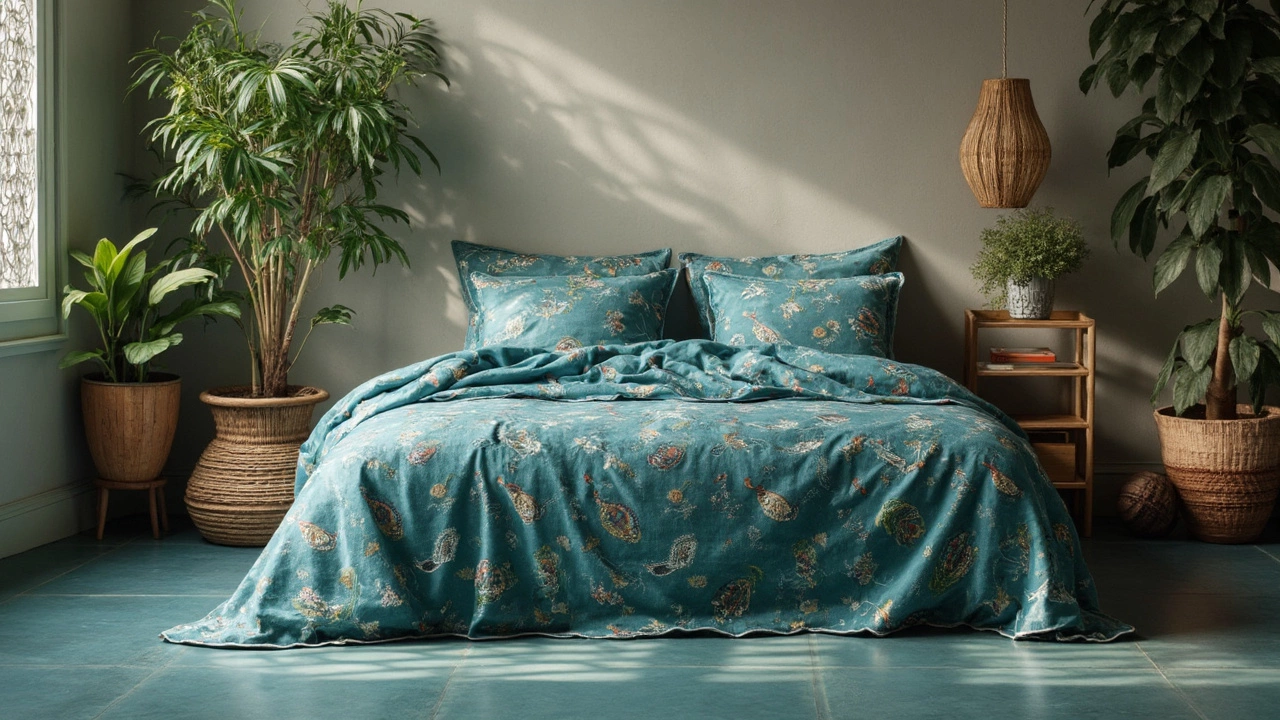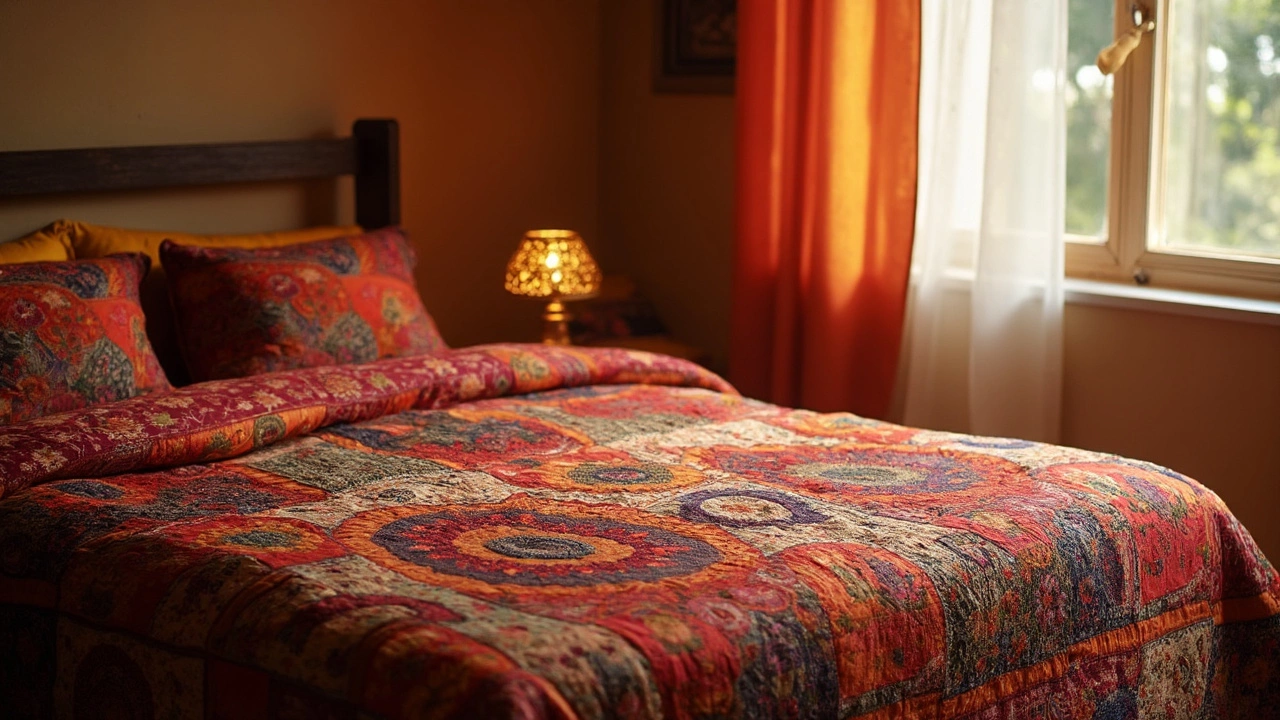Ever wondered what that thin layer covering your bed is called? You're probably thinking of a quilt or a coverlet. While they might seem like just another piece of bedding, these thin bedspreads have a unique purpose and charm.
Understanding what sets them apart starts with knowing their make-up. Typically, a quilt is a three-layered textile, consisting of a soft padding nestled between two fabric layers, while a coverlet is a lighter, woven bedspread usually used for decorative purposes or lightweight warmth.
Choosing the right one can depend on a few factors. Consider the climate—if you're in a warmer region, a light coverlet might be your go-to. In chillier weather? You might want something with a bit more substance, like a quilt. And then there's style. Coverlets and quilts add texture and color to your bedroom decor, allowing you to mix and match designs that suit your taste.
Understanding Thin Bedspreads
When it comes to bedding, thin bedspreads like quilts and coverlets often don't get the credit they deserve. These lightweight options bring more than meets the eye, offering both functional and aesthetic value.
Quilts and Coverlets: What's the Difference?
At a glance, quilts and coverlets might seem the same, but they have their distinctions. A quilt typically consists of three layers: a top fabric, a soft inner filling, and a backing. Quilting stitches hold these layers together in patterns which not only add design but make them sturdier. Coverlets, on the other hand, are generally woven, not quilted, and tend to be thinner with no middle layer. They usually drape over beds but don't always reach the floor, making them perfect for layering or decorative use.
Why Choose a Thin Bedspread?
So, why might you choose one of these over a thicker option? Here are a few practical reasons:
- Temperature Control: Thinner layers like quilts and coverlets are ideal for regulating temperature, preventing overheating, especially during warmer months.
- Versatility: They can be easily swapped out as seasons change, allowing you to refresh your bedroom look without a full makeover.
- Affordable Upgrades: Investing in a new quilt or coverlet is often cheaper than buying a full bedding set. It's a cost-effective way to upgrade your style.
Now, let's take a look at some interesting variations you might encounter.
Fun Styles and Origins
| Style | Origin |
|---|---|
| Patchwork Quilt | America |
| Kantha Quilt | India |
| Matelassé Coverlet | France |
Each style brings a different vibe to your room. Patchwork quilts, often made from scraps, boast vibrant designs, while Kantha quilts offer unique textures with their traditional stitching. Matelassé coverlets are famous for their raised patterns, imitating hand-stitched designs.
Choosing the right thin bedspread can elevate your bedroom and provide practical, year-round comfort. Understanding their characteristics allows for an informed decision that matches your lifestyle and decor.
Types and Materials
When it comes to thin bedspreads, there are a few popular types you'll want to consider. Each of these comes with its unique feel and function. Let’s break it down so you know what you're getting.
Quilts
Quilts are quite the classic choice. They're typically made with three layers—a top, a soft batting or fill in the middle, and a bottom. The magic happens in the stitching. It's not only decorative but also holds the layers in place. You’ll find them in various materials, but cotton and polyester blends are among the most common. Want something with a handmade touch? Look for handmade quilts that add a touch of artistry to your bed.
Coverlets
Coverlets are another lightweight option. They're often woven or quilted, but lighter than a traditional quilt. Think of them as your bed's fashion statement. Coverlets are great for layering or to stand alone in warmer periods. These are usually made from cotton or a cotton blend, which makes them breathable and easy to care for.
Throw Blankets
Though not your traditional bedspread, smaller throws can double up as a lightweight cover. They're versatile and come in a wealth of materials like wool, fleece, or acrylic. They're perfect for adding a pop of color or a cozy touch to your setup.
Materials to Consider
Picking the right material can make all the difference. Here's a quick look at what you might consider:
- Cotton: Known for its breathability, hypoallergenic nature, and softness. Ideal for covering yourself when the heat is on.
- Polyester: Durable and tends to be wrinkle-resistant. It's also budget-friendly.
- Linen: Absorbent and gives off a crisp vibe, making it perfect for summer.
- Blends: Combining materials like cotton-poly offers the benefits of both durability and comfort.
By now, you should have a better idea of what type and material of thin bedspread might suit you best. Whether you're going for a classic quilt feel, a stylish coverlet, or a cozy throw, there’s something snug just waiting out there for you.

Benefits and Uses
Why should you consider a thin bedspread for your bedding ensemble? The answer lies in versatility and practicality. Let's dive into how these light layers can be a valuable addition to your bedroom.
Perfect for Layering: One of the major perks is their ability to be layered. They fit snugly between sheets and thicker duvets, offering extra warmth for cold nights without making you feel suffocated. During the warmer months, a single thin bedspread acts as the ideal bed cover.
Budget-Friendly and Stylish
Unlike heavier options that can be costly, lightweight quilts and coverlets are generally more affordable. They come in an array of colors and designs, making it simple to refresh your bedroom style without breaking the bank. Switch them out seasonally, or just when the mood strikes.
Easy Maintenance
If you've ever tried washing a giant comforter, you know it can be a hassle. Thin bedspreads are often machine washable, and their lighter weight means drying time is reduced, making upkeep a breeze.
Ideal for Allergies
For allergy sufferers, less bulk means fewer places for dust mites and allergens to hide, especially with regular washing. Consider materials like cotton or hypoallergenic fibers for added protection.
Quick Climate Adjustments
Perhaps the most underrated benefit is their adaptability. With climate change stirring unpredictable weather patterns, it's handy to have a bedding option that can easily be added or removed as needed.
In essence, thin bedspreads like quilt and coverlet options offer a blend of style, convenience, and cost-effectiveness that's hard to beat. Whether for practical purposes or a seasonal refresh, these pieces hold their own in any bedroom setting.
Choosing the Right One
Picking out the right thin bedspread can feel a bit like navigating a maze, but it doesn't have to be complicated. Let's break down a few key tips to make sure you're cozy and stylish all at once.
Your Climate Matters
Start by thinking about your local weather. Living in a warm area? A lightweight coverlet should do the trick, keeping things breathable and comfy. If you're dealing with chillier nights, a quilt with a bit more heft is probably a better choice.
Material Choices
Next up, consider the fabric. Cotton quilts are very popular because they're soft and easy to care for. If you're after luxury, silk adds a fantastic touch but can be a bit more delicate. Looking for something eco-friendly? Bamboo fibers can be a cool choice and are also really durable.
Size and Fit
Make sure your bedspread fits your bed properly. It might seem obvious, but an oversized quilt can create unwanted bulk, while an undersized one might leave your toes cold. Check your mattress dimensions before you shop. Don’t forget to consider the depth of your mattress – some thicker styles may need larger sizes.
Design and Style
And finally, style isn't just about grabbing the first pretty pattern you see. Think about your bedroom's color palette and design. Solid colors are timeless, but don't shy away from lively patterns if your room could use a splash of excitement. Florals, geometric shapes, or classic stripes – there's a design for every taste.
Choosing the perfect bedspread isn't just about aesthetics; it's about creating a comforting space. Keep these tips in mind, and you'll find a match that's as practical as it is beautiful.
